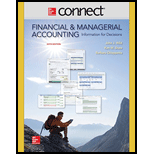
Concept explainers
Asset:
Asset may be regarded as a resource for the person or entity which holds it with a specific economic value and the benefits derived from such asset are generally divided over the lifespan of such asset .Also, they are held to reap some future benefits on account of pooling the funds at present. An asset may be in tangible or intangible form depending upon the nature of asset.
Equity:
An ownership interest in any kind of security or it may also be regarded as the difference value of the assets held and liabilities against the said assets. Also, in the financial statement of the company the funds contributed by the owners and any of the retained or ploughed back earnings (or losses) are regarded as shareholder's equity.
Liability:
A liability may be regarded as the burden or it depicts the obligatory aspect related to a transaction and that it is to be fulfilled in the near future. They mainly form part of the financial statements so that the end users may analyze the current standing of the entity in terms of its liabilities against the possession of its assets.
To identify: (1) the type of account as an asset, liability, equity, revenue, or expense; (2) identify the normal balance of the account; and (3) enter debit (Dr.) or Credit (Cr.) to identify the kind of entry that would increase the account balance.
Want to see the full answer?
Check out a sample textbook solution
Chapter 2 Solutions
Connect 2 Semester Access Card for Financial and Managerial Accounting
- sub general accountingarrow_forwardDuring the current year, August Corporation began operations with $150,000 cash contributed by shareholders. The company purchased equipment for $80,000 cash and inventory for $45,000 on account. By year-end, they had collected $120,000 in service revenue, paid $32,000 for operating expenses, and made payments of $38,000 to suppliers. If the ending inventory balance was $12,000, what is the total stockholders' equity at year-end? Provide answerarrow_forwarddear expert I need help in this question with good method.arrow_forward
- Can you explain this general accounting question using accurate calculation methods?arrow_forwardHarmony Outdoors plans to sell 6,300 camping tents at $95 each in the coming year. The unit variable cost is $56.05 (includes direct materials, direct labor, variable factory overhead, and variable selling expense). Fixed factory overhead is $28,500, and fixed selling and administrative expenses are $41,200. Calculate the variable cost ratio. Calculate the contribution margin ratio. solve this questionarrow_forwardI am searching for a clear explanation of this financial accounting problem with valid methods.arrow_forward

 AccountingAccountingISBN:9781337272094Author:WARREN, Carl S., Reeve, James M., Duchac, Jonathan E.Publisher:Cengage Learning,
AccountingAccountingISBN:9781337272094Author:WARREN, Carl S., Reeve, James M., Duchac, Jonathan E.Publisher:Cengage Learning, Accounting Information SystemsAccountingISBN:9781337619202Author:Hall, James A.Publisher:Cengage Learning,
Accounting Information SystemsAccountingISBN:9781337619202Author:Hall, James A.Publisher:Cengage Learning, Horngren's Cost Accounting: A Managerial Emphasis...AccountingISBN:9780134475585Author:Srikant M. Datar, Madhav V. RajanPublisher:PEARSON
Horngren's Cost Accounting: A Managerial Emphasis...AccountingISBN:9780134475585Author:Srikant M. Datar, Madhav V. RajanPublisher:PEARSON Intermediate AccountingAccountingISBN:9781259722660Author:J. David Spiceland, Mark W. Nelson, Wayne M ThomasPublisher:McGraw-Hill Education
Intermediate AccountingAccountingISBN:9781259722660Author:J. David Spiceland, Mark W. Nelson, Wayne M ThomasPublisher:McGraw-Hill Education Financial and Managerial AccountingAccountingISBN:9781259726705Author:John J Wild, Ken W. Shaw, Barbara Chiappetta Fundamental Accounting PrinciplesPublisher:McGraw-Hill Education
Financial and Managerial AccountingAccountingISBN:9781259726705Author:John J Wild, Ken W. Shaw, Barbara Chiappetta Fundamental Accounting PrinciplesPublisher:McGraw-Hill Education





